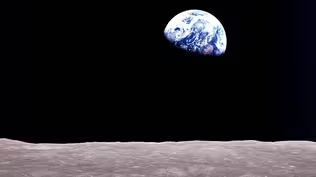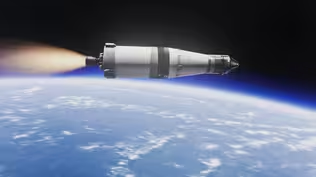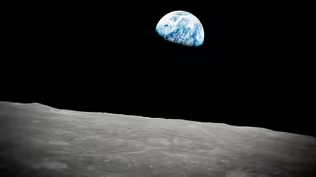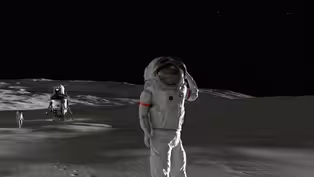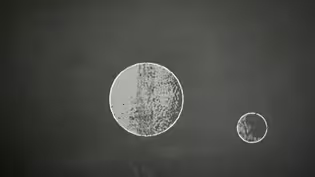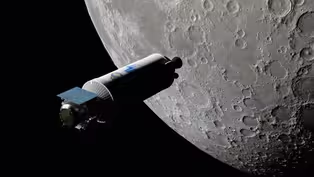
Back to the Moon
Season 46 Episode 11 | 53m 32sVideo has Audio Description, Closed Captions
Discover why scientists and entrepreneurs alike have their sights set on the Moon again.
Fifty years after humans first set foot on the Moon, new scientific discoveries are fueling excitement for a return to the lunar surface—this time, perhaps, to stay. Join the scientists and engineers working to make life on the Moon a reality.
See all videos with Audio DescriptionADProblems playing video? | Closed Captioning Feedback
Problems playing video? | Closed Captioning Feedback
National Corporate funding for NOVA is provided by Carlisle Companies and Viking Cruises. Major funding for NOVA is provided by the NOVA Science Trust, the Corporation for Public Broadcasting, and PBS viewers.

Back to the Moon
Season 46 Episode 11 | 53m 32sVideo has Audio Description, Closed Captions
Fifty years after humans first set foot on the Moon, new scientific discoveries are fueling excitement for a return to the lunar surface—this time, perhaps, to stay. Join the scientists and engineers working to make life on the Moon a reality.
See all videos with Audio DescriptionADProblems playing video? | Closed Captioning Feedback
How to Watch NOVA
NOVA is available to stream on pbs.org and the free PBS App, available on iPhone, Apple TV, Android TV, Android smartphones, Amazon Fire TV, Amazon Fire Tablet, Roku, Samsung Smart TV, and Vizio.
Buy Now
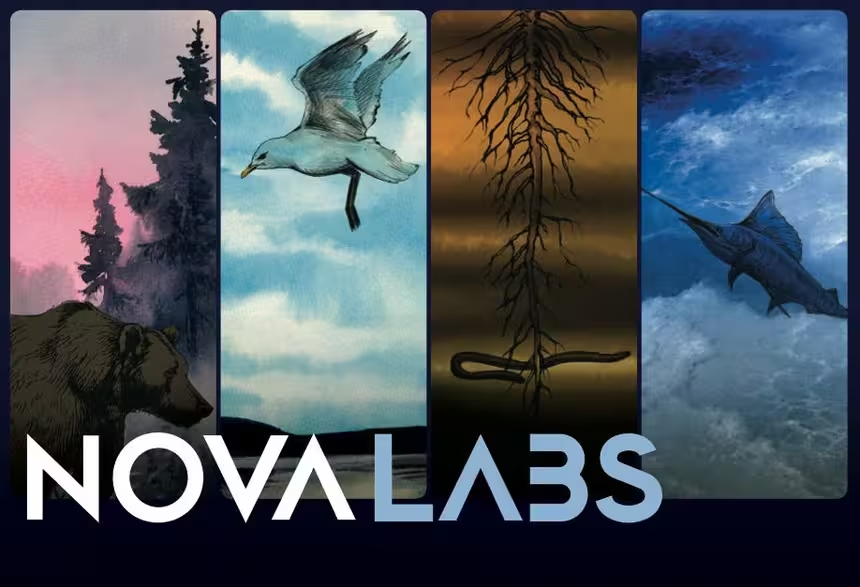
NOVA Labs
NOVA Labs is a free digital platform that engages teens and lifelong learners in games and interactives that foster authentic scientific exploration. Participants take part in real-world investigations by visualizing, analyzing, and playing with the same data that scientists use.Providing Support for PBS.org
Learn Moreabout PBS online sponsorship♪ NARRATOR: Fifty years after humans first set foot on the moon, it may finally be time to go back.
ANGEL ABBUD-MADRID: We have seen a literal explosion of interest in the last five years or so.
Now it's not just one or two countries.
It's the whole world interested in going.
NARRATOR: This time it's different.
This time we want to stick around.
Now has come the time for us to make the next giant leap.
TIM FERNHOLZ: NASA hopes it will become an enabler for lots of different activity on the moon.
NARRATOR: But how would we do that?
And why?
What's changed since the 1970s?
GEORGE SOWERS: We discovered that the moon is rich in metal deposits, large amounts of titanium and iron.
Space resources will be the next great economic revolution for humankind.
NARRATOR: And a critical life-supporting resource.
We think we have found ice.
TIMIEBI AGANABA-JEANTY: If we do find water in space, that's pretty much the most significant discovery that we could have.
This is an indication that living on the moon might be possible.
NARRATOR: But is it a game changer?
Could we actually live off the moon's resources and build a self-sufficient human presence beyond Earth?
Are we about to pioneer a new frontier, taking the next giant leap for humankind?
There's only one way to find out.
It's "Back to the Moon," right now, on "NOVA"!
♪ NARRATOR: December 14, 1972.
The final Apollo mission prepares to return to Earth.
GENE CERNAN (via radio): ...are you ready for me to go to the...?
As I take man's last step from the surface, for some time to come-- but we believe not too long into the future-- I believe America's challenge of today has forged man's destiny of tomorrow.
NARRATOR: As the last man ever to walk on the moon leaves, Gene Cernan dreams of a future when people will return.
(engine igniting) CERNAN (via radio): We leave as we came and God willing as we shall return, with peace and hope for all mankind.
NARRATOR: But that hope fails to materialize.
Years become decades, and there is no return.
Now, 50 years later, that may be about to change.
Humanity has its sights set on the lunar surface once more.
In January 2019, China's Chang'e 4 mission becomes the first spacecraft to soft land on the moon's far side.
And a few months later, Israel attempts to become the fourth nation to soft land a robotic probe on the moon.
JOHN THORNTON: The idea that a small country could land on the surface of the moon is a very audacious goal.
(whirring, igniting) NARRATOR: And missions to return people to the moon are also taking shape.
NASA has a plan to build something called the Lunar Gateway, which will orbit the moon as a spacecraft and allow astronauts to shuttle back up and down from the surface.
KATIE JOY: There's a real sense of hope in the community that we are within ten years of putting people back there.
NARRATOR: But why go back now?
What's changed since the end of the Cold War moon race?
Recent discoveries suggest there's much more to the moon than meets the eye.
SOWERS: There are large metal deposits, large amounts of titanium and iron.
Space resources will be the next great economic revolution for humankind.
NARRATOR: Such resources on the moon could kickstart a new space economy.
ABBUD-MADRID: Now it's the private sector, they want to see if they have a valid business case of economic activity that can happen on the moon.
NARRATOR: But with this new economic interest come new questions.
AGANABA-JEANTY: Is it even possible to exploit resources without ownership rights?
NARRATOR: Still, at least nine private companies are forging ahead... ♪ banking on a future that includes regular traffic to the moon.
But getting there is still costly and hard to achieve; staying there even harder.
So what would it take to establish humanity's first foothold on another world?
(radio chatter, beeping) ♪ BRETT DENEVI: The moon is inspiring because it is so real to people.
It's something that we see from our houses every night.
♪ (shutter clicks) The moon is this gorgeous record of solar system history and just a few days away waiting for us to go explore.
NARRATOR: Brett Denevi is in charge of the high resolution cameras on NASA's latest moon mapping mission-- the Lunar Reconnaissance Orbiter, or LRO.
DENEVI: LRO's mission was to essentially scout the surface of the moon for future human exploration.
NARRATOR: LRO was called for in 2004 by President George W. Bush as part of his initiative to return humans to the lunar surface.
GEORGE W. BUSH: Beginning no later than 2008, we will send a series of robotic missions to the lunar surface to research and prepare for future human exploration.
(engine igniting) NARRATOR: Launched in 2009, part of LRO's mission is to survey the surface of the moon.
DENEVI: The moon really preserves a complete geologic record back to nearly the formation of the solar system.
NARRATOR: LRO is offering new insights into the moon's complete geological history, from a point almost as tall as Everest to giant Mare basins half the size of continents, and strange topography unlike anything on Earth.
And this is our first look at how the moon's surface is still changing today.
DENEVI: We can actually map the entire moon every month.
We're detecting the formation of new impact craters that have formed since we've been in orbit.
So, that's really the reason why we need these very high-resolution images that we get from the LRO, to pick out scientifically interesting landing sites to enable future human exploration.
NARRATOR: Dreams of living and working on the moon go back a long way.
In the early 1960s, the U.S. Army had a design for an elaborate, permanently manned lunar base called Project Horizon.
♪ When Apollo astronauts finally arrive, the discoveries they make in the rocks actually add credibility to this dream.
BUZZ ALDRIN (via radio): Hey, Neil, didn't I say we might see some purple rocks?
NEIL ARMSTRONG (via radio): Find a purple rock?
ALDRIN: Yep.
Very small, sparkly... NARRATOR: Geologist David Kring has spent his career studying their composition.
KRING: When the first samples were returned by the Apollo 11 astronauts, scientists didn't know what to expect.
Was the moon composed of samples like asteroids that we had analyzed as meteorites, or was the moon much like the Earth-- a complex planetary body?
Scientists, like myself, use what we call a petrographic microscope, to transmit light through very, very thin slices of rock to identify the minerals.
NARRATOR: The rocks revealed that the moon is a geologically complex world-- much like Earth-- with lots of different minerals.
Lurking amongst those samples were these basalts.
These were samples that we realized were produced when lavas flooded the surface of the moon and when we analyzed them, we realized that they had minerals that were sometimes accompanied by ilmenite.
Ilmenite is a mineral that looks completely opaque in our samples.
This mineral is composed of iron, titanium, and loads of oxygen.
♪ With the Apollo-era discovery of the moon's potential mineral wealth, some credible thinkers seriously suggested that the lunar surface could be a source of materials for building bases off Earth, among them the legendry science fiction writer Isaac Asimov and co-inventor of the particle accelerator, physicist Gerard O'Neill.
O'NEILL: The Apollo astronauts, in many of their flights, were picking up, just casually, chunks of rock on the lunar surface.
They were 40% aluminum by weight.
ASIMOV: And the moon is very rich in titanium too, which we never use enough of here on Earth because-because steel is so much cheaper.
But you could do things with titanium that can be very cute.
♪ NARRATOR: By using these resources on the moon, O'Neill suggested that we could build large habitats floating in free space.
Such structures would be too expensive to build and launch from Earth, as the modestly sized but costly $100 billion International Space Station demonstrates.
But if the raw materials are already available in space then all kinds of construction activities become conceivable.
And that's where the moon comes in.
O'NEILL: Basically what we're saying is, the whole key to making habitats which are built in free space for a reasonable cost is to get about 98% of the material from the surface of the moon.
That's essential because it's always going to be very expensive to bring things up from here.
♪ NARRATOR: The moon is attractive as a source of raw materials for one simple reason: gravity.
(sawing, shearing sound) SOWERS: When you want to lift something off a planet, your number one adversary is gravity.
Rockets leaving Earth have a pretty steep hill to climb.
Our planet's huge mass pulls them back down.
We're stuck in what we call a gravity well.
NARRATOR: Earth has the deepest gravity well of all the rocky planets.
It's over 20 times deeper than the moon's, which is more of a dimple than a well.
That low gravity is dramatically displayed by the astronauts' graceful bounds across the surface.
And the fact that getting back into lunar orbit requires only a relatively low-powered rocket motor.
SOWERS: Therefore anything that we can develop or manufacture using lunar materials has an enormous cost advantage to anything that comes from Earth.
Material that we can get on the moon will cost less than one-tenth of what it would cost to launch from Earth.
ABBUD-MADRID: By utilizing the resources in space instead of bringing it from Earth, everybody benefits from that because now we don't depend from the resources from Earth.
♪ NARRATOR: But getting back to the moon will require more than the allure of mineral resources.
It needs something far more valuable-- water.
KRING: Prior to Apollo, the question of water hadn't even been raised.
When the Apollo samples were collected, we did not have the analytical capabilities to detect any water in the samples.
(waves crashing) NARRATOR: If there was liquid water on the moon, it's long gone.
With no atmosphere to preserve it, liquid water cannot exist on the lunar surface.
And the rocks the astronauts returned appeared to be totally lacking in water.
KRING: In fact, at the time, it was inferred that the moon was largely a dry planet.
♪ Without water it was impossible to live off the land.
We would constantly have to resupply our exploration effort from the surface of the Earth.
♪ NARRATOR: The aridity of the Apollo rock samples would seem to rule out the dream of living self-sufficiently on the moon.
But they do hold clues about how the moon formed and from that springs new hopes of living there one day.
♪ Katherine Joy is a planetary scientist who studies the chemistry of the moon and the evolution of the early solar system.
JOY: There were several theories for how the moon first formed.
One is the capture theory, whereby the moon was actually thought to be an early planet that got captured by Earth's gravity and went into orbit around it.
There's also a slightly strange idea that maybe the early Earth is spinning really fast on its axis and spun off a piece of the moon and this is what we call the fission hypothesis.
However, our ideas have changed since we collected the Apollo samples.
And the samples told us that actually the moon and the Earth are chemically similar.
And this gave rise to this new model called the giant impact hypothesis.
We're still figuring out the details, but maybe the Earth was hit by a body the size of Mars, (loud crash) creating a massive shower of super-heated material: gas, dust, magma, that then cooled down slowly and coalesced, forming the Earth at the center and the moon trapped in orbit around it.
NARRATOR: If formed from the same materials, Earth and the moon would have held a lot of water locked inside their hot interiors, gradually releasing it onto their surfaces as they cooled.
This raised an intriguing possibility: might the moon also have once been wet like Earth?
KRING: Once we realize that water actually is within the interior of the moon, we realize that when those lavas were erupted to the surface, those gases would've been carried and liberated at the surface.
NARRATOR: Geologists set out to estimate the amount of gas that would have come from the moon's interior.
KRING: We calculated that the volume of magma erupting was, at times, so great that it filled space around the moon with these gases producing a transient atmosphere.
♪ NARRATOR: According to the impact theory-- as the moon cooled and volcanic eruptions ceased-- most of this atmosphere-- including the water vapor-- would have been lost into space.
♪ This left the lunar surface exposed to a vacuum-- resulting in a freeze-dried world.
♪ So even if there had once been water on the moon, it seemed to be long gone.
But not everyone gave up on the idea of lunar water.
Apollo 17 astronaut and geologist Harrison Schmitt remembers the research.
An old friend of mine, Ken Watson and Harrison Brown at Caltech in the 1960s did the theoretical analysis that showed that if water is released anywhere on the moon, some of it will end up being trapped in the permanently shadowed regions.
NARRATOR: Permanently shadowed regions don't exist on Earth because our axis is tilted, casting sunshine onto both of Earth's polar regions at different seasons over the year.
But the moon is different.
SOWERS: Because the moon is only tilted a degree and a half relative to the sun, the sun is always coming in at a grazing angle at the lunar poles and over the course of a lunar day, which happens to be 28 Earth days, the sun will travel around in a full circle but always stay at a grazing angle.
♪ NARRATOR: This is because the sun never shines straight down onto the moon's poles.
And thanks to the moon's unique topography, you get conditions unlike any on Earth.
The moon is a topographic wonderland.
It has hills and valleys, that produce an extraordinary amount of elevation changes over very short distances.
That topography casts very long and deep shadows, particularly near the poles and sometimes those shadows are so deep and so long that the floors of those craters never, ever see the sun.
JOY: It means that they have very cold temperatures, almost down to the surface temperature of Pluto, which is just incredible when you think about how far Pluto is away from the sun.
NARRATOR: As seen on this color-coded heat map, temperatures on the moon vary widely-- ranging from 260 degrees Fahrenheit in the sunlight to minus-280 degrees in the shade.
But in the permanently shadowed regions, at the poles, it can be colder than minus-400 degrees-- just 60 degrees above absolute zero.
Any type of volatile, whether it be water or carbon dioxide, is going to be frozen out and trapped in those cold spots.
NARRATOR: The theory suggests that traces of water left inside the moon from its formation, and ice delivered by comets and asteroids impacting the surface, could have become trapped in these cold spots.
(meteorites crashing) JOY: It just gets stuck there.
And it gets preserved, and it can't escape, and it's been there for a very long time.
Permanently shadowed regions are really exciting scientifically and also really important for our future exploration ambitions on the moon.
NARRATOR: But all of the Apollo landings were near the moon's equator-- nowhere near the potential cold traps at the poles.
And the idea that ice may be present on the lunar surface may have remained just that-- an idea if not for yet another ambitious Cold War-era attempt to trump the Soviets.
(rocket screeching) In the late 1980s, the U.S. military is developing its Star Wars initiative to protect the country from incoming nuclear weapons.
One version of their secretive designs involves a flotilla of small satellites to detect and collide with intercontinental ballistic missiles.
Needing an object to test the satellite's targeting sensors, the Pentagon chooses... the moon.
The resulting lunar mission is named "Clementine."
With its launch comes an opportunity for NASA to participate.
Due to its military nature, mission control is located out of sight in a non-descript building-- nicknamed "the Bat Cave"-- in downtown Washington D.C. Planetary scientist Ben Bussey undertakes the task of constructing a new atlas of the moon assembled from the mission's images.
BUSSEY: A lot of the Apollo data were in an equatorial orbit, where essentially you go around the waist of the moon, where the astronauts landed.
Whereas because with the Clementine we wanted global coverage, Clementine was in what's called a polar orbit, which is where if you picture the moon, it's going like that, so it goes over both poles every couple of hours.
NARRATOR: Such a flight path could give scientists their first opportunity to search for the permanently shadowed cold traps-- predicted to exist at the poles.
♪ By bouncing Clementine's communication signals off the moon's polar regions, a bit like a radar pulse, the mission scientists hope that any ice might show up by reflecting the radio waves.
As data pours into the Bat Cave, everyone is glued to their screens.
BUSSEY: It was in the floor of Shackleton Crater, inside that permanently shadowed crater that they saw this signal was consistent with buried ice.
♪ NARRATOR: On March 12, 1996, the Pentagon summons the press to reveal their discovery.
Well, yes, the answer is we think we have found ice.
This is an indication that living on the moon might be possible.
You may be looking in this photograph, of possibly the most valuable piece of real estate in the solar system.
NARRATOR: The discovery of water ice on the moon re-ignites dreams of harnessing space resources for a lunar base.
But how much water is really there?
And could it be harvested economically?
♪ In 2008, as NASA prepares to launch the Lunar Reconnaissance Orbiter to image the moon, a change of plan requires a different rocket for the launch.
The new vehicle has the power to carry almost a ton of extra payload to the moon.
Can they use that extra capacity to take a closer look at the water ice Clementine glimpsed?
The opportunity piques the interest of Anthony Colaprete, a young planetary scientist at NASA's Ames Research Center.
♪ COLAPRETE: We said, "Okay, what if we crash something into the moon and we looked at the ejecta?"
I called up Pete because he's the guy you go to if you want to crash something into another body, planetary body, he knows impacts.
And I thought, (laughing): "Oh, yeah, bash something into the moon?"
Well, this was something that was going to smash through to an area you couldn't see in the cold traps.
NARRATOR: By crashing an object into the moon, they hope to observe lunar material ejected from the impact and determine if it contains ice.
(beeping sound) COLAPRETE: So we came up with the idea of, "Why don't we use the spent upper stage of the rocket that was pushing us to the moon?"
NARRATOR: Ingeniously, by using part of the rocket itself as the impactor, they can then use the extra payload space for a separate spacecraft carrying instruments that will follow a few minutes behind, recording the impact at close range, and hurriedly sending its data back to Earth, before smashing into the moon itself.
(man talking via radio) Such a complex mission is hard to pull off with such little time, but the rewards-- should they succeed-- will be huge.
SCHULTZ: I was really intrigued and I knew that we could do this, but the idea of actually using a spent rocket, that was almost like crazy talk.
NARRATOR: Anthony and Peter calculate that they would need to create a debris cloud at least half a mile high to stand a chance of detecting any water.
To test the feasibility, they turn to a trusty tool from the Apollo era.
(snaps in place) (keys clacking) (whirring) COLAPRETE: This facility is the Ames Vertical Gun Range.
It's a large vertical gun used for firing projectiles into targets to study cratering processes.
SCHULTZ: We have a battery of high-speed cameras, going up to a million frames per second.
We can look at it from different locations, just be able to simulate, get a sense of what we might see.
MAN: High voltage is good.
We have ready lights.
(siren blaring) NARRATOR: Firing projectiles at high speed into a simulated lunar surface... (loud snap) Peter and Anthony spend months trying to figure out what the impact plume might look like.
(loud collision) SCHULTZ: Stop, stop!
Go backwards.
(mouse clicking) That's the projectile coming down.
(laughs) Okay.
Pow!
(loud collision) SCHULTZ: The idea behind these experiments were to get a better handle on getting enough material into sunlight from that deep hole.
If we didn't get enough material, we were dead.
(engines roaring) NARRATOR: LCROSS launches on June 18, 2009.
♪ It takes four months to catch up with the moon and get into position for impact.
In the early evening of October 8, 2009, the Centaur rocket stage impactor begins its approach.
MAN (over radio): All stations flight.
30 seconds to end of science cal.
NARRATOR: With the spent rocket stage and following spacecraft now on unstoppable impact trajectories with the moon, all Peter and Anthony can do is watch and wait.
MAN (over radio): Mark transition to DV mode.
♪ NARRATOR: At 3:31 in the morning Pacific time, the Centaur hits.
♪ Minutes later, the shepherding craft follows and starts collecting data, rushing to transmit it before its own demise.
(loud collision) COLAPRETE: So we had a press conference... of course, everyone's like, "Well, what'd you see?
"Did you see water?
Did you see this?"
"How much?
How much?"
Yeah, "How much."
Indeed, yes, we found water, and we didn't find just a little bit, we found a significant amount.
In the 20 to 30 meter crater outcross maybe we found maybe about a dozen of these two gallon buckets worth of water.
NARRATOR: Finding so much water in such a relatively small area changes everything; and heralds new excitement for lunar exploration.
♪ SOWERS: The LCROSS is the most direct evidence that we have that there's water at the poles of the moon.
Recent estimates on the quantity of water at the lunar poles are on the order of one billion metric tons per pole.
That's an enormous quantity of water.
The discovery of water on the moon is pretty much the most significant discovery that we could have for the future of space exploration.
NARRATOR: It isn't only a moon base and orbiting colonies that would benefit from a lunar supply of water.
Lunar water could actually open up the entire solar system to human exploration-- and that's because of its unique chemistry.
♪ SELLA: Water is made of hydrogen and oxygen combined, in that famous formula H2O, and what that means is that we can split it to release the hydrogen and the oxygen.
Let me show you what I mean.
What I've got here is a beaker and you can see that it's got two beautiful carbon electrodes sitting in it.
Plus we've got two test tubes which are going to allow us to collect things.
And what we're going to do is we're going to do electrolysis.
As they say in all good monster movies, "Turn up the power, Igor."
(electricity humming) NARRATOR: As the electricity starts to flow through the circuit, the positively charged hydrogen is attracted to the negative terminal, and the negatively charged oxygen to the positive terminal.
SELLA: And so what we can see is myriad bubbles coming up, of course, twice as much on this side as the other.
♪ We're splitting H20 into hydrogen and oxygen.
Two hydrogens.
One oxygen.
The beauty of hydrogen is the fact that you can burn it with oxygen and what you get is an incredibly hot flame.
In other words, you're going to produce huge amounts of really hot gas that can push your rocket.
But if we want to get an idea of what's actually in that test tube, then what I think we should do is to actually set fire to it.
I'll get some safety glasses on.
And what I'm going to do is I'm going to take that tube out of the water.
And now what I need to do is to light it.
(lighter stick clicks) (loud pop) And you get that beautiful squeaky pop that's characteristic of hydrogen.
This is good stuff.
MAN: Two, one, zero, and lift off!
NARRATOR: It's such good stuff because as the hydrogen reacts with the oxygen, almost all of it is converted to water, releasing huge amounts of energy.
SOWERS: Hydrogen and oxygen, together they're the most efficient chemical propellants known.
The Space Shuttle main engines burned hydrogen and oxygen; many rockets today, the Delta IV rocket uses hydrogen and oxygen.
It's kind of the fuel of choice for high-energy rocket stages.
NARRATOR: So mining lunar ice could provide water to drink, air to breathe, and a source of propellant for spaceships to fuel up and head out.
♪ SOWERS: A source of propellant outside of Earth's gravity well is incredibly important because it then lowers the cost of everything else that we want to do.
Being able to refuel in space is incredibly useful, it's a game changer.
It would lower the cost of a Mars mission by factors of two or more.
And my message to senior officials at NASA is that that ought to be the first thing we do in our return to the moon plan.
NARRATOR: It's one thing for governments to subsidize the search for water ice on the moon, but quite another to bankroll the construction of a rocket fuel factory in space.
To accomplish that would likely take more than just a promise of profits in the distant future.
ANDREW CHAIKIN: That space economy time and time again has proven not to be a compelling enough economic draw to motivate governments to spend the kind of money that's required to make it happen.
That's why, to me, the key to going back to the moon is making access to space more affordable, more routine, for us to become a truly space-faring species.
♪ NARRATOR: Fifty years after the first moon landings, NASA has its sights set on getting back to the lunar surface more affordably, by sharing the cost with commercial partners.
MAN: ...ignition and lift off of the Falcon 9 to the Space Station.
♪ FERNHOLZ: Now NASA can say, "Well, we saved money by hiring private companies "to go to the space station, can we do the same thing on the moon?"
♪ NARRATOR: In 2018, NASA announced a new commercial program where the agency would buy flights to the moon's surface from private companies.
♪ Nine U.S. businesses are now competing to return America to the moon, funding most of the effort themselves.
One of them is Pittsburgh based Astrobotic.
THORNTON: Some of the biggest challenges when we first started was to figure out how do we fund this thing.
Flying to space is expensive, buying a launch to space is expensive.
How do we generate the dollars to go and make this thing happen?
♪ NARRATOR: Finding potential customers to build a sustainable lunar landing business means Astrobotic needs to create a market for its services.
♪ THORNTON: When we first started there was no market for payload delivery to go up to the surface.
We had to show people, "Here's how it works, here's what you can do on the surface of the moon."
Everything from rovers that can drop and drive off into the distance, to science experiments, to magnetometers and radiation detectors, and even infrastructure-- all of the parts and pieces of the future lunar economy.
NARRATOR: With no business demand on the moon yet, Astrobotic's services have mostly attracted customers who simply want to deliver personal items to the moon.
But one national space agency has also signed up-- Mexico's A.E.M., which plans to use Astrobotic to land a package of scientific instruments.
Space agencies are interested because they can land on the surface of the moon with us and actually have a lunar program for a fraction of what it costs the superpowers 50 years ago.
Once we land on the surface of the moon, we become the local utility, we provide power and communications for the payloads that come with us.
♪ NARRATOR: Whether such a business model can sustain Astrobotic's lunar ambitions remains to be seen.
They haven't even reached space yet, let alone landed on the moon.
(metal creaking, loud thud) It's not easy doing this on a budget.
SpaceIL, another small company, crashed their $100 million moon lander during an attempt to land in April 2019.
Landing on the moon is still hard.
Until recently, only Russia and the U.S. had accomplished it.
♪ But in 2013, China joined this exclusive club when it's Chang'e 3 lander touched down; followed by Chang'e 4 in January 2019, which made the first landing in history on the moon's far side.
In the coming years, robotic landers from India, Japan, and Europe are also scheduled to attempt to reach the lunar surface.
ABBUD-MADRID: First you will find countries that want to access it driven by being the first ones to be there.
That's going to be a period of excitement that we now are back on the moon, that we are now landing there.
But eventually, you're gonna have to find a reason why you want to stay there, and this is where resources of the moon come in, because now you have a justification of, "Now we can use these resources that will sustain an outpost."
♪ NARRATOR: Current lunar exploration is still funded primarily by governments, but if the cost of getting there drops, then the promise of so many resources to exploit could trigger a new space race-- one not driven by politics but by profits.
And that raises important new questions like who owns the moon?
ABBUD-MADRID: The ethical question is: who would have access to these resources?
It is only those countries that can launch rockets and extract them?
And how are those other countries that do not have this capability, how are they going to benefit from that?
The U.S. position has clearly been that the U.S. will recognize resources that are developed by its nationals.
They will recognize that as the property of those nationals.
But there are others saying, "You can't commercialize, you can't exploit, because you have no ownership rights."
So, half of the world will take a hands-off approach and say, "Let's see where it goes," and then start to regulate.
Today it's the United Nation's Outer Space Treaty that sets our legal framework for working beyond Earth.
But it's never been tested to address the idea of space resources.
(drilling) While the legality of mining the moon remains open for debate, NASA continues its efforts to make exploring the moon technically feasible, and the agency hopes others will join them.
PENCE: Now has come the time for us to return American astronauts to the moon.
(applause) NARRATOR: In March 2019, Vice President Mike Pence committed America to reaching the moon once again.
Last year, NASA and American innovators began designing the Lunar Gateway.
And we are rallying the world to join us in this vital work.
FERNHOLZ: The Lunar Gateway, will orbit the moon as a spacecraft and allow astronauts to shuttle back up and down from the surface, performing research.
That is going to have a component that's a public-private partnership; sharing the costs and the benefits of its work, not just with commercial partners, but also with other countries along the lines of the International Space Station.
NARRATOR: By pioneering a human return to the moon in this way, NASA hopes to create a market for businesses that seek to provide lunar services.
But will it work?
Can NASA's next step back to the moon become a giant leap, literally, for all humankind?
AGANABA-JEANTY: If this is just the same partners as the International Space Station, then we haven't really progressed far.
What has to be recognized right now is that there are over 65 countries who are investing over $10 million in space, and most of them are developing in emerging countries.
So who's going to be invited to the table?
What does that mean for participation in something like the Lunar Gateway mission?
♪ NARRATOR: The Lunar Gateway mission is not the only program under development for getting humans back to the moon.
Some visionary U.S. companies are also pursuing their own avenues... although it's not always clear where hype ends and reality begins.
(cheers and applause) In 2018, Elon Musk's rocket company SpaceX introduced its first fare-paying lunar passenger-- Japanese entrepreneur Yusaku Maezawa.
Thank you, Elon.
Thank you, everyone.
I choose to go to the moon!
(cheers and applause) FERNHOLZ: Elon Musk has sold a ride on his next rocket, to a Japanese billionaire who wants to take a dozen artists on a cruise past the moon.
It sounds ludicrous, but then let's say that private companies say, "We have learned how to go to the moon and bring tourists."
Then you might have habitats being built and permanent life on the moon.
♪ NARRATOR: Inspired by a time when humans last lived on the moon and we dreamed of moving humanity into space, Amazon founder Jeff Bezos, is also building his own road to the moon through a company he founded called Blue Origin.
BEZOS: Let me show you something.
NARRATOR: And they already have a plan to put a large lander down on the lunar surface.
BEZOS: This is Blue Moon.
(cheers and applause) We've been working on this lander for three years.
It's time to go back to the moon, this time to stay.
(cheers and applause) FERNHOLTZ: I feel that there's enough energy, and more importantly money, going towards this that we will see real exploration in the years ahead.
NARRATOR: The vision of all these plans is ultimately to set up lunar bases, where explorers, including the first women to reach the moon, can live and work for extended periods.
There will, of course, be many challenges, as one man who's already lived there can tell you.
SCHMITT: The living conditions on the moon will be very similar to living conditions that I experienced.
They're going to need the consumables that are necessary to survive-- oxygen, water-- all of which can be supplied by the moon.
So I think the resource issue is not a major one.
They're going to need an aggregate of individual habitats from various launches here from Earth initially.
Before very long, I think we'll be manufacturing habitats on the moon; converting lunar dust to actual materials and components.
♪ NARRATOR: In anticipation, a team of engineers at NASA's Kennedy Space Center is already building experimental robots for such assignments.
♪ The group is known as Swamp Works.
Rob Mueller is NASA's senior technologist there.
MUELLER: NASA's Swamp Works is an innovation environment.
It's a collection of labs where we develop new technologies in order to have revolutionary advances in space.
NARRATOR: Construction on the moon requires a radically different approach from doing it on Earth.
On Earth, when you want to dig, you get a big, yellow machine that weighs a lot and you push and you have enough reaction force to dig because of the gravity on Earth.
The problem is, when it arrives on the moon, its actual weight is one-sixth of that.
The gravity on the moon is one-sixth of the gravity on Earth.
So, because it doesn't weigh very much, there's no reaction force, it can't penetrate the soil, it can't pick it up.
Unfortunately, we cannot launch a giant bulldozer into space on a rocket, it's too expensive.
So, we had to reinvent excavation, reinvent digging.
We scratched our heads and-and thought about it, and we came up with a new design, which has counter rotating bucket drums.
The forces cancel each other out and now you can dig with a very small robot.
♪ NARRATOR: Their new moon rock digger-- called RASSOR-- is put through its paces in Swamp Works' lunar surface simulator.
It turns out that the lower gravity on the moon is not the only challenge.
As the Apollo astronauts discovered, moon dust itself poses a serious problem.
MUELLER: The particles are jagged.
In fact, in the Apollo missions, when they put the gloves on the suit, there was a joint, and that glove lasted three days.
So, we have to find ways to cope with this sharp, jagged dust that sticks to everything.
NARRATOR: To keep machines functioning in this harsh environment, Rob and his team are developing a novel way to fix broken equipment.
If RASSOR is operating and it breaks a wheel, what do you do?
Our answer to the logistics problem is don't bring it, make it there.
What we've done is we've taken the local crushed rock, and that gives you a way of 3D printing a structure.
3D printing a spare wheel on the moon.
It's a very crude wheel, but it's a start.
NARRATOR: Constructing replacement equipment with local resources may prove essential if a moon settlement is to be self-sufficient.
And while Swamp Works' digger still needs to prove itself on the moon, one day machines like it could be working alongside humans to construct a lunar base.
♪ But there may be a simpler way to live on the moon-- that is, if we're willing to live in the moon.
One of the most fascinating discoveries in recent years are these sinkholes, giving us a view down into a lava tube.
NARRATOR: Lava tubes form when volcanic eruptions continue for long enough that the top layer of lava cools and solidifies-- allowing more molten lava to continue flowing beneath it.
DENEVI: Much of the moon's surface is covered by lava flows, and in some cases you can actually see evidence of where they may have flowed inside lava tubes.
People are really interested in these because future human explorers could have that be a location for future human habitation on the moon.
NARRATOR: Could these natural cave systems in the moon really offer shelter to future astronaut explorers?
We're yet to discover what's inside them, but exploring similar tubes here on Earth might offer clues.
Tommaso Santagata is mapping lava tubes on Mt.
Etna, one of the most active volcanoes on Earth.
SANTAGATA: I use 3D mapping instruments to analyze the shapes inside these caves, in order to compare this data with caves on the moon.
Lidar works with a laser and this measures about three million points.
This laser turns around in 360 and it creates a 3D map of any environment.
♪ NARRATOR: By correlating sink hole geometry to the size and shape of the caves they open into here on Earth, scientists hope to be able to determine which sink holes on the moon could be the best candidates for future lunar exploration.
SANTAGATA: By studying a sink hole we could estimate the dimension of the lava tube below, and we can draw a map of the lava tubes by dot-to-dot.
On the moon we know that probably there are caves that are more than 100 kilometers long.
NARRATOR: With the potential for hundreds of miles of tunnels just below the moon's surface offering natural protection from the harsh lunar environment, subterranean shelters might one day become our first homes on another world.
ARMSTRONG (via radio): It's quite dark here in the shadow-- a little hard for me to see that I have good footing.
♪ NARRATOR: Fifty years ago, Neil Armstrong's first step onto the moon's surface taught us that anything is possible.
DENEVI: Well, Neil Armstrong, when he was first on the moon, said it has a stark beauty all its own.
And so, yes, in one sense you can think of it as just a barren rock, but I also just love the beauty and excitement of future human exploration on the surface of the moon.
SCHMITT: Being outside the spacecraft for the first time looking around this magnificent valley we were in, deeper than the Grand Canyon, with brilliantly illuminated slopes and a blacker than black sky, and the fact that you're there seeing it and that human beings have put you there, really, it gives you a lot of confidence of what we may be able to do with our civilization in the future.
♪ NARRATOR: In the years after we left the lunar surface, most of us forgot about exploring the moon.
But in the last decade, since LRO reached lunar orbit, NASA has shown us a new view of the moon, which has made us look at it again with new eyes.
("Clair de Lune" by Claude Debussy playing) ARMSTRONG (via radio): It has a stark beauty all its own.
It's different-- but it's very pretty out here.
AGANABA-JEANTY: I really believe that the focus should be on creating an equitable environment here on Earth where everybody has opportunities to imagine themself one day doing high-tech science that can take them to the moon.
("Clair de Lune" continues playing) Wow!
ALDRIN: Beautiful view.
ARMSTRONG: Ain't that something?
Magnificent sight out here.
ALDRIN: Magnificent desolation.
MUELLER: I think it's important to work on space exploration because it has implications for civilization.
It's very rare that you can work on something that will affect everybody on Earth.
It's a grand challenge.
CHAIKIN: I would love to see the day when people can go outside and look up at night and see the lights of a lunar base.
That'll be an incredible moment for the human species when we can look up at the moon and know that there is a branch of humanity that's there.
("Clair de Lune" continues playing) ♪ ♪ ♪ ♪ ♪
Video has Closed Captions
Preview: S46 Ep11 | 28s | Discover why scientists and entrepreneurs alike have their sights set on the Moon again. (28s)
Video has Closed Captions
Clip: S46 Ep11 | 1m 1s | Scientists have several theories for how Earth's Moon formed. (1m 1s)
Scientists Launch Rocket into the Moon to Find Water
Video has Closed Captions
Clip: S46 Ep11 | 4m 35s | Researchers hope to observe lunar material ejected from an impact. (4m 35s)
Providing Support for PBS.org
Learn Moreabout PBS online sponsorship
- Science and Nature

Capturing the splendor of the natural world, from the African plains to the Antarctic ice.













Support for PBS provided by:
National Corporate funding for NOVA is provided by Carlisle Companies and Viking Cruises. Major funding for NOVA is provided by the NOVA Science Trust, the Corporation for Public Broadcasting, and PBS viewers.



